Fact Sheet FS099
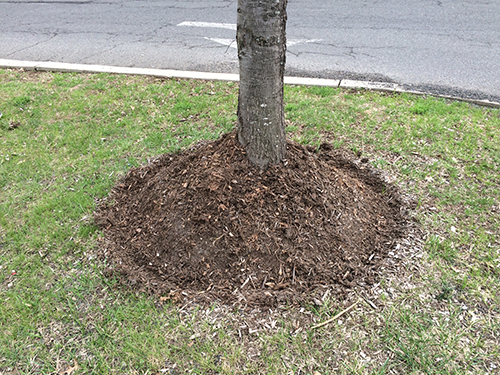
Figure 1. Mulch piled against a trunk.
Mulching trees, shrubs, and flower beds is a recommended landscape maintenance practice with many benefits, yet it can literally kill plants when applied improperly. Properly used, mulches provide both aesthetic and functional benefits to urban landscapes, including improvements to soil moisture, fertility and temperatures, and reductions in weeds, diseases, soil erosion, and compaction, among other benefits. Mulching is especially useful in the establishment of newly transplanted trees in landscapes receiving minimal care. It is also a benefit in shrub and perennial gardens. Conversely, excessive use of mulches, like a mountain of mulch piled high against the tree trunk (Figure 1) may not kill a tree immediately, but it will result in a slow decline and death. Over-mulching is a leading cause of death of azaleas and rhododendrons, dogwood, boxwood, mountain laurel, holly, cherry trees, ash, birch, linden, spruce, and many other landscape plants.
Standard Mulching Recommendations
Mulch may be one of the best, or one of the worst things you can do for your plants, depending on how you use it. In general, mulch depth should not exceed a total of 3 inches, including the mulch remaining from previous years and the current season's application. However, on compacted and poorly drained soils, mulch depths should not exceed 2 inches, especially for shallow-rooted plants and those requiring high rootzone aeration, such as Rhododendron and other acid-loving species.
Soil texture and depth should also be taken into consideration when determining the type and depth of mulch to apply, particularly in those soils with high clay and/or silt content or heavy compaction, as is commonly found in most urban environments. Soils that are frequently waterlogged, as in wetland situations, or receiving high precipitation or irrigation, may not need any mulch. Coarser textured mulches can be placed a bit deeper due to better oxygen diffusion into the soil. Finer textured mulch, such as double-shredded mulch, should be applied in thinner, 1- or 2-inch layers. Note that fine-textured mulches can repel water when they dry, in part due to how well they knit together and in part because dry organic matter is by nature hydrophobic (water repelling). A light raking of the existing mulch may be all that is needed to break through the crusted or compacted layers, allowing the water to once again soak through and into the soil.
Over-Mulching Can Kill
How does over-mulching kill trees and shrubs? Here are some common causes:
Oxygen Starvation
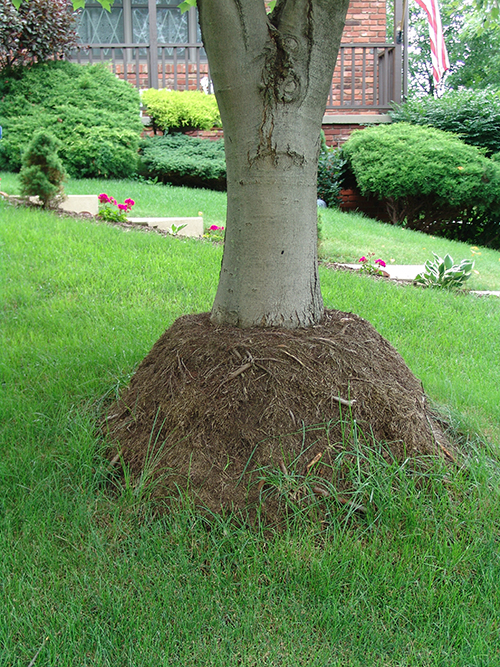
Figure 2. Feeder roots growing in excessive mulch. Photo credit: Sandy Feather, Penn State Extension.
Suffocation of the roots is the most common cause of tree and shrub death from over-mulching. Repeated applications of mulch in areas with high precipitation or high irrigation can contribute to waterlogged conditions. With water occupying most of the pore space in the mulch and upper soil layers, air content is minimal and both the movement and availability of oxygen is greatly reduced. Roots need oxygen for respiration, and when its level in the soil drops below 10%, root growth in most trees declines. Once too many roots decline and die, the plant subsequently goes into decline as well.
The adverse effect of excessive amounts of mulch is especially prevalent during wet periods in the spring and the fall when active root growth is observed in many tree species. Oxygen deprivation is also prevalent in soils that do not have good drainage, such as in heavily compacted urban settings. Symptoms may take several years to appear, depending on the plant and the soil type. Symptoms include off-color and yellowing foliage (chlorosis), abnormally small leaves, poor twig growth, and dieback of older branches. Unfortunately, by the time the symptoms are noticed, it is generally too late to correct the problem. At this point, the plant is usually in a state of irreversible decline, and will most likely die.
Compounding the problem, if the mulch is applied in a thick layer (over 6") up against tree trunks and over roots in an attempt to minimize weed growth, some tree species will extend their fine feeder roots up into the mulch, where there may be a better balance of moisture and aeration than in waterlogged or oxygen depleted soils below. This can create potential issues during extended droughts. The mulch will dry out more rapidly than the soil, and much of the root system that has spread throughout the mulch will die, affecting overall tree health and survival.
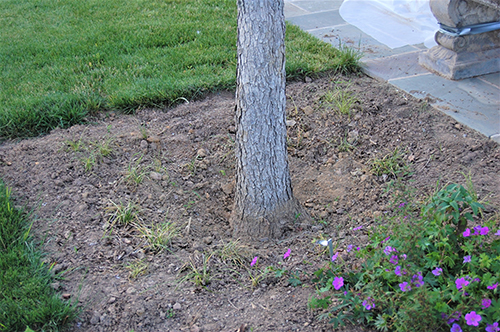
Figure 3. An excavated root flare of a tree planted too deep.
Inner Bark Death of Aboveground Root Flares
Inner bark (phloem) death comes from piling mulch directly against the stems/trunks of trees and shrubs at and above the root flare. Stems/trunks at the root flare have tissues that are quite different from those on roots. These tissues cannot survive a continually moist environment and must be able to "breathe" through pores called "lenticels." When mulch is piled around trunks, gas exchange decreases under heavy rainfall or irrigation, stressing and ultimately killing the inner bark tissue. This also occurs when trees are planted too deep and the root flare is buried. Once the inner bark dies, roots become malnourished and weakened, resulting in a subsequent reduction in water and nutrient uptake by the roots. The entire health of the plant is affected, and thus its eventual survival.
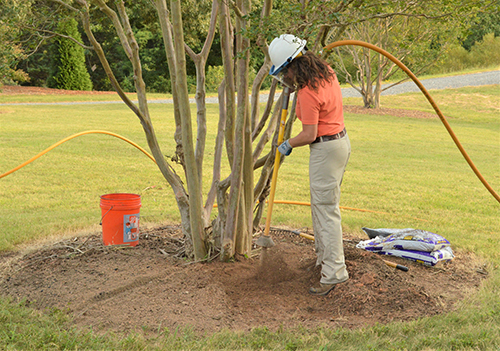
Figure 4. Pneumatic air spade exposing buried root flares.
If you suspect a problem with excess mulch around the root flare, dig through the mulch layer to determine its actual depth and pull any mulch back from plant stems and trunks. A rule of thumb is to maintain mulch 3 to 5 inches away from the stems of young plants or shrubs, and 8 to 12 inches away from mature tree trunks. Visually look for the presence of a root flare, as some or all may be buried and must be exposed. Remove all soil or mulch up to the junction of the root flare and trunk collar (taking care not to damage the tender bark) to expose the entire root flare, as seen in Figure 3. Leave the resulting well open and exposed to air. Research shows that a large number of plants have rapidly improved in color and vigor within months of root flare excavations. Professional arborists often employ an industrial pneumatic air spade to expose the buried root flares and alleviate soil compaction in mature or specimen trees, leading to remarkable recoveries in overall health and aesthetics (Figure 4). This air-spading method breaks up compacted soil without damaging the roots of most tree species.
Disease
Most fungal and bacterial diseases require moisture to spread and reproduce. Trunk diseases gain a foothold in the moist, decaying bark tissue under the mulch. Once established, the disease organisms ultimately invade the inner bark, disrupting the flow and storage of sugars produced during photosynthesis (starving and finally killing the plant). Often this scenario is accompanied by bark beetles and borers that are also attracted to stressed plants expediting the decline and allowing entrance of other fungal pathogens into the plant.
Excess Heat
Wet mulch layers piled up next to the trunk may begin to heat up when the bark begins to decompose. This scenario is similar to composting, where temperatures within inner mulch layers may reach 120° to 140° F. This high heat may directly kill the inner bark/phloem of young plants, or may prevent the natural hardening off period that plants must go through in the fall in preparation for the winter. If the trunk flare tissue is not sufficiently hardened off before freezing weather arrives, the tissue may die, the roots may not receive adequate amounts of photosynthetic sugars, and the plant will ultimately decline.
Other Drawbacks of Over-Mulching
Soil pH
The soil pH, or acidity/alkalinity level, may also be changed by the continuous use of the same type of mulch. In particular, pine bark mulch is quite acidic (pH of 3.5 to 4.5), and can cause the soil to become acidic with constant use year after year. After the soil becomes acidified, some nutrients are not available for the plant to absorb, and others, such as iron, manganese, and zinc, become readily available at high, toxic levels. Symptoms of micronutrient toxicity mimic those of Phytophthora wilt. Sometimes, plants cannot tolerate micronutrient toxicity, becoming stressed and killed by secondary disease organisms and insects. On the other hand, hardwood barks are initially acidic, but ultimately may cause the soil to become too alkaline (basic), causing acid loving plants, including azaleas, rhododendrons and blueberries to decline because of micronutrient deficiencies of iron, manganese and zinc. Symptoms appear as yellowing of foliage, often with prominent green veins. To avoid the above-mentioned problems, regularly check the soil pH and rotate the type of mulch used.
Rodents
Piles of mulch next to the trunk may also provide cover for rodents such as mice and meadow voles. Living under the warm mulch in the winter, these rodents chew on the inner bark. This often goes unnoticed until the following spring when the "tree doesn't look good." If the trunk is girdled (>50% chewed around the trunk), there is little that can be done to save the plant outside of bridge grafting.
Nitrogen Deficiency
"Fresh" or non-aged (uncomposted) mulches may cause nitrogen deficiencies in many young plants. Decomposing bacteria need an ample supply of nitrogen to break down the mulch. Since bark mulches have little nitrogen available, the bacteria utilize the soil nitrogen. This process may cause nutrient deficiencies, especially when fine-textured mulch is mixed down into the soil. Look for symptoms of leaf yellowing on new growth. This is considered a temporary condition.
Alternative Mulch Recommendations
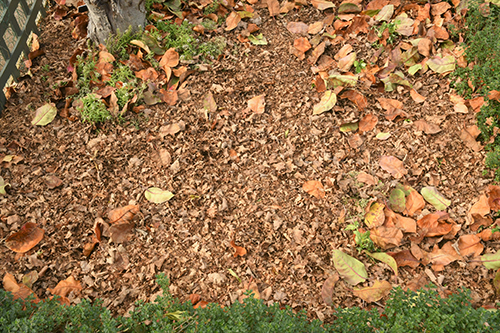
Figure 5. Shredded leaves to be used as a mulch.
Consideration may also be given to using a mulch other than shredded wood or bark. Public gardens, such as Longwood Gardens in Kennett Square, PA and Wave Hill in New York City, are using shredded leaves as a mulch with great effect (Figure 5). Unlike wood-based mulches, shredded leaves do not knit together quite as tightly. As a result, they do not become as hydrophobic as wood products, allowing an easier passage of rain and irrigation into the soil beneath. Use of leaves as a mulch requires them to be shredded with a pass or two of a lawnmower, as they are less likely to blow around as compared to whole leaves. Shredded leaves also do not compact as readily as a layer of whole leaves.
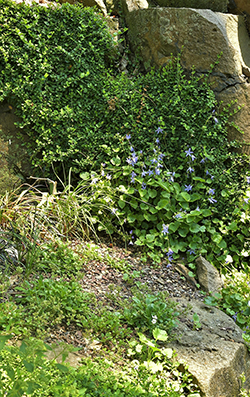
Figure 6. Gravel color should repeat that of larger stones.
As all organic mulches decompose, their functional and aesthetic landscape benefits require periodic reapplications. Inorganic mineral materials like gravel, lava rock, brick and stones, and synthetic materials like shredded rubber tires, have been used as mulching materials and usually do not require as frequent reapplications. The inorganic materials provide greater benefits than bare soil, while creating specific landscape effects. However, some of these materials contribute to undesirable soil compaction and reflective heat loads. Others can release chemically-reactive substances that negatively affect soil properties and biota/microorganisms, and potentially cause plant toxicities. For example, white limestone chips have been a popular ornamental inorganic mulch, but have the drawback of raising the soil pH, often to the detriment of some plants within the bed. The reflected sunlight from the limestone can also be problematic for others. The consensus is that inorganic mulching materials should be minimally used (in fairly thin layers), and mostly for decorative purposes to cover bare soil.
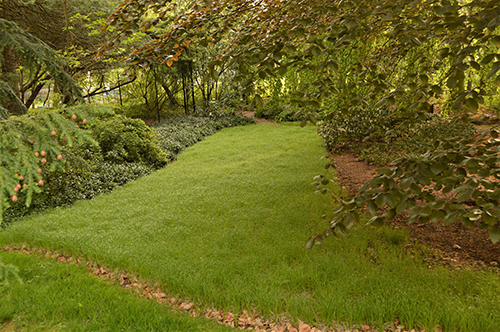
Figure 7. Oak Sedge in a residential garden.
When developing a rock garden, select a gravel mulch that matches the color of the existing bedrock or the larger stones used in the design, making the appearance more cohesive. This is illustrated in the outcrops at Buck Gardens, Somerset County, NJ as pictured in Figure 6. Plants that prefer a drier crown, such as succulents and herbs, perform better with a 1–2" layer of quick draining gravel than a wood-based mulch. Most stone yards carry a ⅜ or ¼" gravel blend that has an attractive diversity of tan, brown and gray colored pieces that accommodates most landscape situations.
One of the main objectives of mulching is to retain moisture for the root system of trees. A large portion of the roots may extend well beyond the canopy drip area (the area beneath the branches of the tree) and are not located at the base of the trunk. Thus, adding mulch only to the area near the base of a tree does not help to conserve much, if any, moisture for the tree to absorb. Where possible, consider expanding the mulched area out to the drip line (the outer edge of the canopy) or beyond. In addition, adding compatible or minimally competing groundcovers to act as a "living mulch" will create a sustainable and self-renewing mulch.
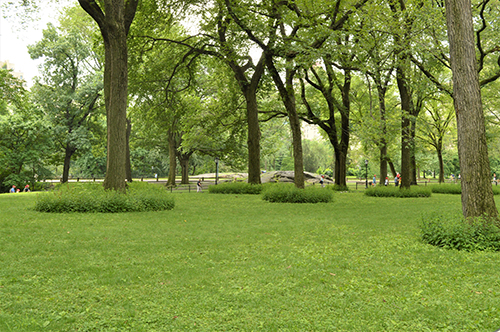
Figure 8. White Wood Aster at the base of trees in Central Park.
As it is commonly observed in woodland plant communities, most trees can tolerate root competition for water and nutrients from woody and herbaceous groundcovers. As these groundcovers grow and expand, they knit together and lessen the need for additional wood-based mulches, reducing annual mulching costs and the associated carbon footprints. Plants such as Oak Sedge (Carex pensylvanica, Figure 7), White Wood Aster (Eurybia divaricata, Figure 8), Hakone Grass (Hakonechloa macra) and Yellowroot (Xanthorrhiza simplicissima) are ideal candidates for installing beneath trees with dense canopies, whereas Cutleaf Stephanandra (Stephanandra incisa 'Crispa'), Mountain Mint (Pycnanthemum muticum), Wild Bergamot (Monarda fistulosa) and Bush Honeysuckle (Diervilla sessilifolia) are best for sunnier locations. Canadian Ginger (Asarum canadense) and Golden Ragwort (Packera aurea) are suggestions for planting beneath shrubs. When adding these groundcovers beneath established trees and shrubs, consider planting 2" diameter plugs as opposed to larger containers in order to minimize disturbance to the soil and damage to the root systems.
Conclusion
For most gardens with well to average-draining soils, mulching is an excellent technique for helping to reduce overall maintenance while improving the beauty of your garden. The challenge is to be cognizant of the best mulch for a given situation and the amount of additional mulch, if any, necessary for each year.
Acknowledgement: This publication is based on the original work authored by Deborah Smith-Fiola, former Agriculture and Natural Resources Agent, Ocean County
References
- Chalker-Scott, L. 2007. Impact of mulches on landscape plants and the environment - A review. Journal of Environmental Horticulture 25(4): 239–249.
- Clatterbuck, W.K. 2003. Mulching Your Trees and Landscapes. Agricultural Extension Service Bulletin SP 617, The University of Tennessee. 4 p.
- Harris, R.W., J.R. Clark and N.P. Matheny. 1999. Arboriculture: Integrated Management of Landscape Trees, Shrubs, and Vines, 3rd Ed. Prentice Hall, Upper Saddle River, NJ (Mulch on Chapter 7, pp. 202-215).
- Kozlowski, T.T. 1985. Soil aeration, flooding and tree growth. Journal of Arboriculture 11:85-96.
- Watson, G.W. and E.B. Himelick. 2013. The Practical Science of Planting Trees. International Society of Arboriculture, Champaign, IL. (Mulch on Chapter 11, pp. 180-183).
Photo Credits: All from Bruce Crawford, except as noted.
July 2021
Copyright © 2024 Rutgers, The State University of New Jersey. All rights reserved.
For more information: njaes.rutgers.edu.
Cooperating Agencies: Rutgers, The State University of New Jersey, U.S. Department of Agriculture, and Boards of County Commissioners. Rutgers Cooperative Extension, a unit of the Rutgers New Jersey Agricultural Experiment Station, is an equal opportunity program provider and employer.

